Abstract
BACKGROUND: Glucagon-like peptide-1 (GLP-1)(7-36) amide is an intestinal incretin hormone which also inhibits gastric acid secretion in humans. Its mechanism of action is unclear, but it strongly inhibits vagally induced secretion (sham feeding), suggesting that it could influence vagal activity. AIM/METHODS: The effect of intravenous GLP-1 (7-36 amide) (1 pmol/kg/min) was studied on pentagastrin induced acid secretion in otherwise healthy subjects, previously vagotomised for duodenal ulcer (n = 8) and in a group of young (n = 8) and old (n = 6) healthy volunteers. RESULTS: Pentagastrin increased acid secretion significantly in all three groups, but the plateau concentration in the vagotomised subjects was lower than in controls. Infusion of GLP-1 (7-36 amide) significantly inhibited acid secretion in the control groups (to 67 (SEM 6) and 74 (SEM 3)% of plateau concentrations in young and old controls, respectively) but had no effect in the vagotomised subjects. Differences in plasma concentrations of GLP-1 (7-36 amide), recovery of gastric marker, duodenal regurgitation, or Helicobacter pylori status could not explain the lack of effect. Blood glucose was lowered equally by GLP-1 (7-36 amide) in all subjects. CONCLUSION: The inhibitory effect of GLP-1 (7-36 amide) on acid secretion depends on intact vagal innervation of the stomach.
Full text
PDF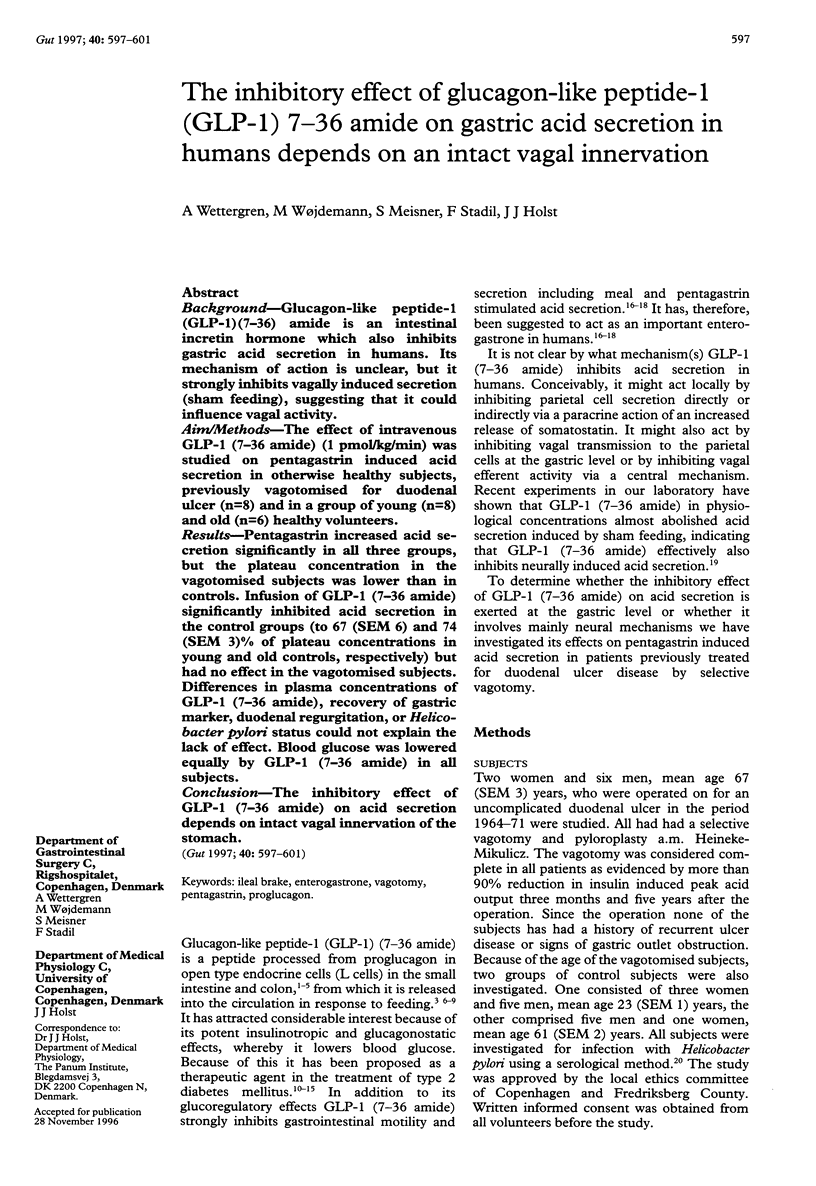
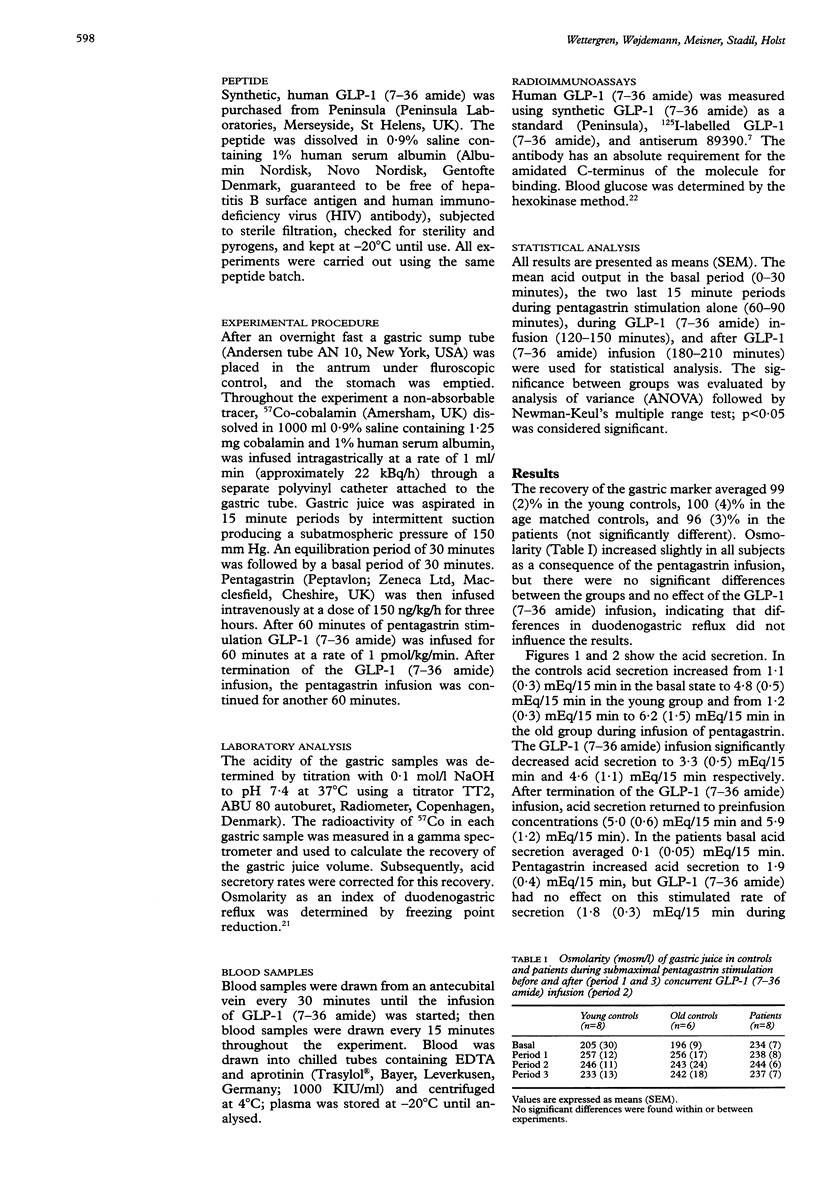
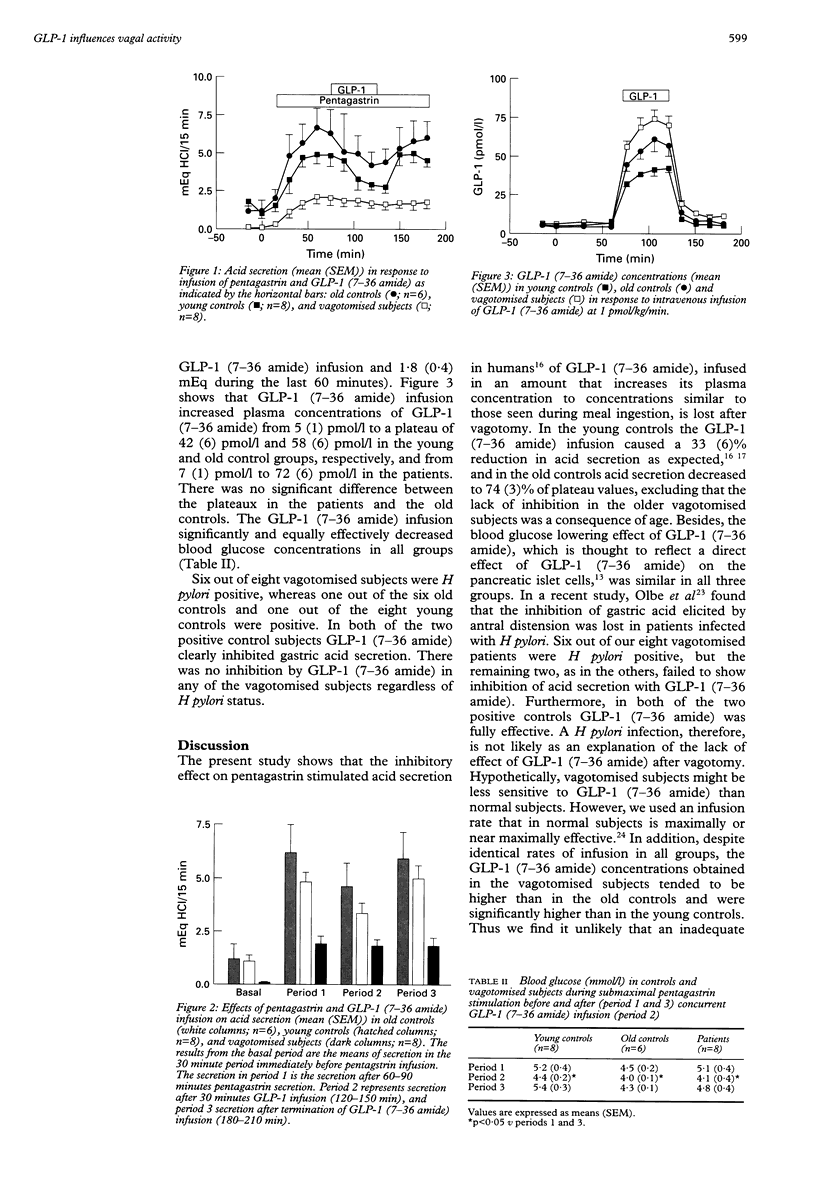
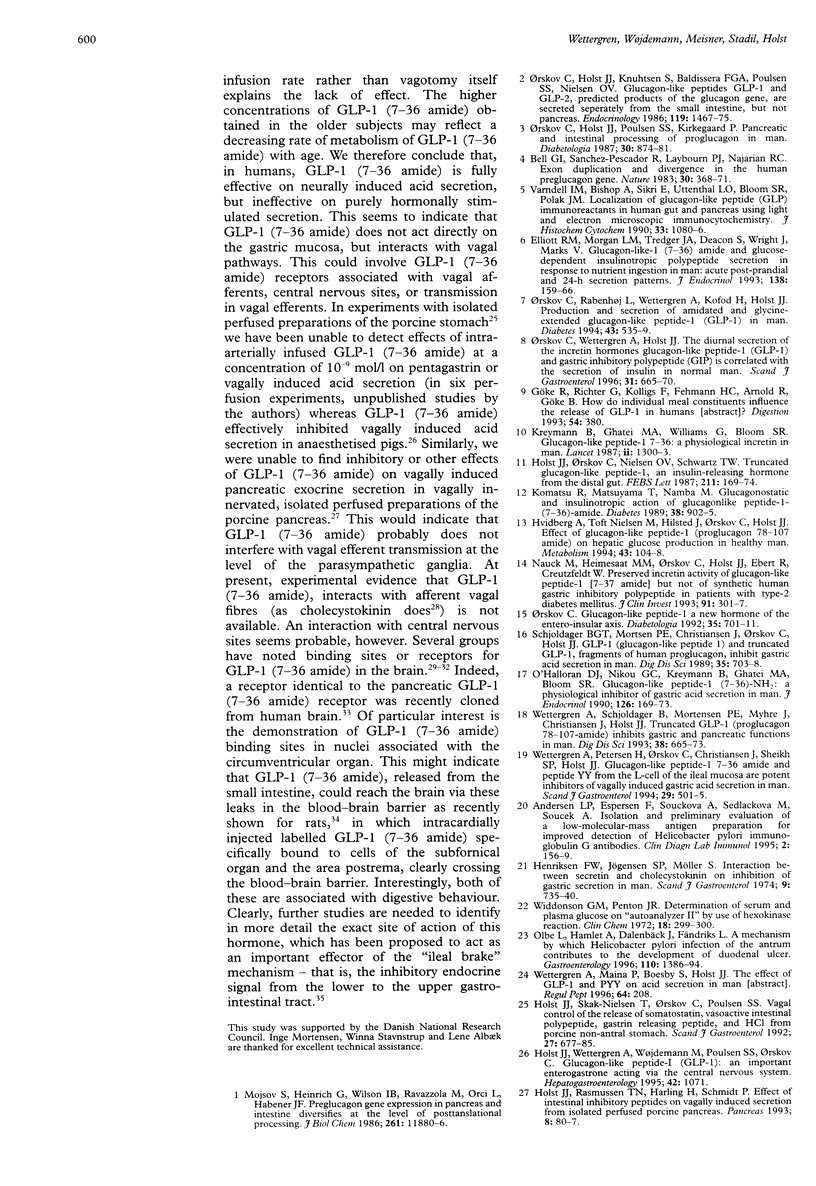
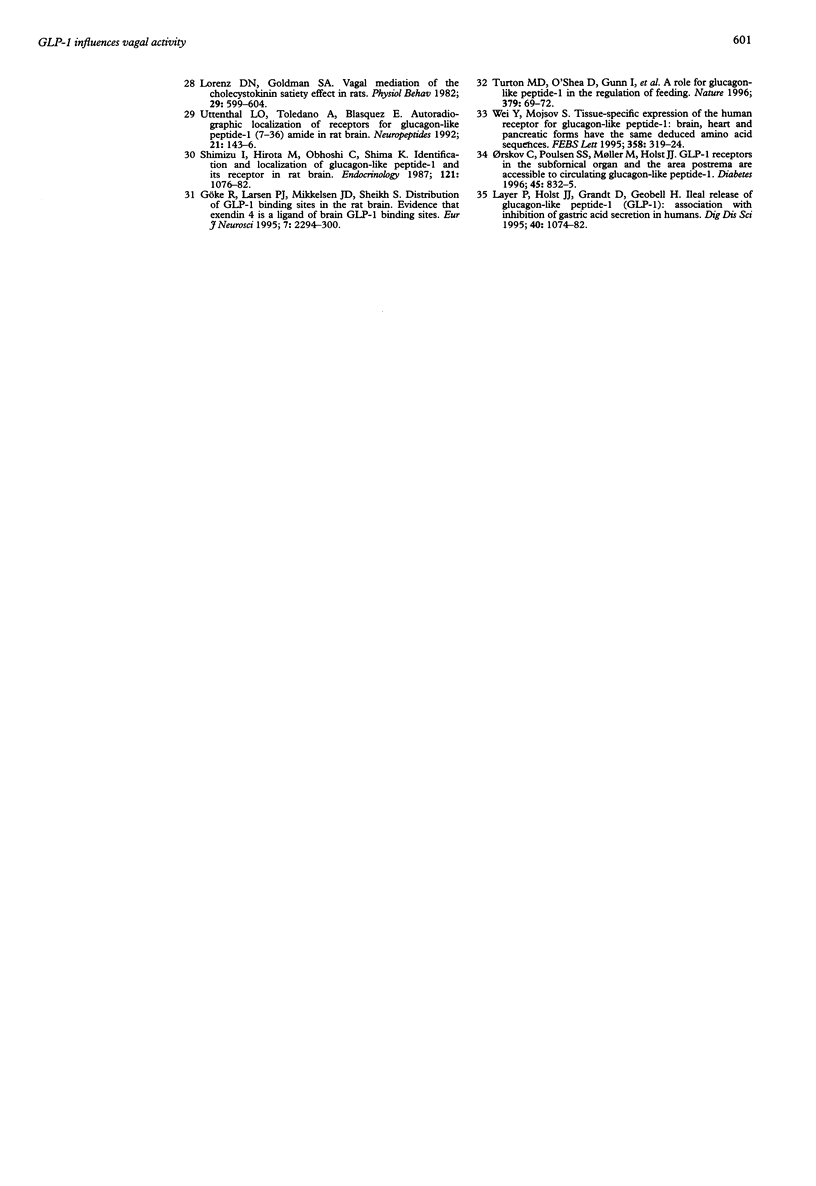
Selected References
These references are in PubMed. This may not be the complete list of references from this article.
- Andersen L. P., Espersen F., Souckova A., Sedlackova M., Soucek A. Isolation and preliminary evaluation of a low-molecular-mass antigen preparation for improved detection of Helicobacter pylori immunoglobulin G antibodies. Clin Diagn Lab Immunol. 1995 Mar;2(2):156–159. doi: 10.1128/cdli.2.2.156-159.1995. [DOI] [PMC free article] [PubMed] [Google Scholar]
- Bell G. I., Sanchez-Pescador R., Laybourn P. J., Najarian R. C. Exon duplication and divergence in the human preproglucagon gene. 1983 Jul 28-Aug 3Nature. 304(5924):368–371. doi: 10.1038/304368a0. [DOI] [PubMed] [Google Scholar]
- Elliott R. M., Morgan L. M., Tredger J. A., Deacon S., Wright J., Marks V. Glucagon-like peptide-1 (7-36)amide and glucose-dependent insulinotropic polypeptide secretion in response to nutrient ingestion in man: acute post-prandial and 24-h secretion patterns. J Endocrinol. 1993 Jul;138(1):159–166. doi: 10.1677/joe.0.1380159. [DOI] [PubMed] [Google Scholar]
- Göke R., Larsen P. J., Mikkelsen J. D., Sheikh S. P. Distribution of GLP-1 binding sites in the rat brain: evidence that exendin-4 is a ligand of brain GLP-1 binding sites. Eur J Neurosci. 1995 Nov 1;7(11):2294–2300. doi: 10.1111/j.1460-9568.1995.tb00650.x. [DOI] [PubMed] [Google Scholar]
- Henriksen F. W., Jörgensen S. P., Möller S. Interaction between secretin and cholecystokinin on inhibition of gastric secretion in man. Scand J Gastroenterol. 1974 Nov;9(8):735–740. [PubMed] [Google Scholar]
- Holst J. J., Orskov C., Nielsen O. V., Schwartz T. W. Truncated glucagon-like peptide I, an insulin-releasing hormone from the distal gut. FEBS Lett. 1987 Jan 26;211(2):169–174. doi: 10.1016/0014-5793(87)81430-8. [DOI] [PubMed] [Google Scholar]
- Holst J. J., Rasmussen T. N., Harling H., Schmidt P. Effect of intestinal inhibitory peptides on vagally induced secretion from isolated perfused porcine pancreas. Pancreas. 1993 Jan;8(1):80–87. doi: 10.1097/00006676-199301000-00015. [DOI] [PubMed] [Google Scholar]
- Holst J. J., Skak-Nielsen T., Orskov C., Seier-Poulsen S. Vagal control of the release of somatostatin, vasoactive intestinal polypeptide, gastrin-releasing peptide, and HCl from porcine non-antral stomach. Scand J Gastroenterol. 1992 Aug;27(8):677–685. doi: 10.3109/00365529209000139. [DOI] [PubMed] [Google Scholar]
- Hvidberg A., Nielsen M. T., Hilsted J., Orskov C., Holst J. J. Effect of glucagon-like peptide-1 (proglucagon 78-107amide) on hepatic glucose production in healthy man. Metabolism. 1994 Jan;43(1):104–108. doi: 10.1016/0026-0495(94)90164-3. [DOI] [PubMed] [Google Scholar]
- Komatsu R., Matsuyama T., Namba M., Watanabe N., Itoh H., Kono N., Tarui S. Glucagonostatic and insulinotropic action of glucagonlike peptide I-(7-36)-amide. Diabetes. 1989 Jul;38(7):902–905. doi: 10.2337/diab.38.7.902. [DOI] [PubMed] [Google Scholar]
- Kreymann B., Williams G., Ghatei M. A., Bloom S. R. Glucagon-like peptide-1 7-36: a physiological incretin in man. Lancet. 1987 Dec 5;2(8571):1300–1304. doi: 10.1016/s0140-6736(87)91194-9. [DOI] [PubMed] [Google Scholar]
- Layer P., Holst J. J., Grandt D., Goebell H. Ileal release of glucagon-like peptide-1 (GLP-1). Association with inhibition of gastric acid secretion in humans. Dig Dis Sci. 1995 May;40(5):1074–1082. doi: 10.1007/BF02064202. [DOI] [PubMed] [Google Scholar]
- Lorenz D. N., Goldman S. A. Vagal mediation of the cholecystokinin satiety effect in rats. Physiol Behav. 1982 Oct;29(4):599–604. doi: 10.1016/0031-9384(82)90226-8. [DOI] [PubMed] [Google Scholar]
- Mojsov S., Heinrich G., Wilson I. B., Ravazzola M., Orci L., Habener J. F. Preproglucagon gene expression in pancreas and intestine diversifies at the level of post-translational processing. J Biol Chem. 1986 Sep 5;261(25):11880–11889. [PubMed] [Google Scholar]
- Nauck M. A., Heimesaat M. M., Orskov C., Holst J. J., Ebert R., Creutzfeldt W. Preserved incretin activity of glucagon-like peptide 1 [7-36 amide] but not of synthetic human gastric inhibitory polypeptide in patients with type-2 diabetes mellitus. J Clin Invest. 1993 Jan;91(1):301–307. doi: 10.1172/JCI116186. [DOI] [PMC free article] [PubMed] [Google Scholar]
- O'Halloran D. J., Nikou G. C., Kreymann B., Ghatei M. A., Bloom S. R. Glucagon-like peptide-1 (7-36)-NH2: a physiological inhibitor of gastric acid secretion in man. J Endocrinol. 1990 Jul;126(1):169–173. doi: 10.1677/joe.0.1260169. [DOI] [PubMed] [Google Scholar]
- Olbe L., Hamlet A., Dalenbäck J., Fändriks L. A mechanism by which Helicobacter pylori infection of the antrum contributes to the development of duodenal ulcer. Gastroenterology. 1996 May;110(5):1386–1394. doi: 10.1053/gast.1996.v110.pm8613042. [DOI] [PubMed] [Google Scholar]
- Orskov C. Glucagon-like peptide-1, a new hormone of the entero-insular axis. Diabetologia. 1992 Aug;35(8):701–711. [PubMed] [Google Scholar]
- Orskov C., Holst J. J., Knuhtsen S., Baldissera F. G., Poulsen S. S., Nielsen O. V. Glucagon-like peptides GLP-1 and GLP-2, predicted products of the glucagon gene, are secreted separately from pig small intestine but not pancreas. Endocrinology. 1986 Oct;119(4):1467–1475. doi: 10.1210/endo-119-4-1467. [DOI] [PubMed] [Google Scholar]
- Orskov C., Holst J. J., Poulsen S. S., Kirkegaard P. Pancreatic and intestinal processing of proglucagon in man. Diabetologia. 1987 Nov;30(11):874–881. doi: 10.1007/BF00274797. [DOI] [PubMed] [Google Scholar]
- Orskov C., Poulsen S. S., Møller M., Holst J. J. Glucagon-like peptide I receptors in the subfornical organ and the area postrema are accessible to circulating glucagon-like peptide I. Diabetes. 1996 Jun;45(6):832–835. doi: 10.2337/diab.45.6.832. [DOI] [PubMed] [Google Scholar]
- Orskov C., Rabenhøj L., Wettergren A., Kofod H., Holst J. J. Tissue and plasma concentrations of amidated and glycine-extended glucagon-like peptide I in humans. Diabetes. 1994 Apr;43(4):535–539. doi: 10.2337/diab.43.4.535. [DOI] [PubMed] [Google Scholar]
- Orskov C., Wettergren A., Holst J. J. Secretion of the incretin hormones glucagon-like peptide-1 and gastric inhibitory polypeptide correlates with insulin secretion in normal man throughout the day. Scand J Gastroenterol. 1996 Jul;31(7):665–670. doi: 10.3109/00365529609009147. [DOI] [PubMed] [Google Scholar]
- Schjoldager B. T., Mortensen P. E., Christiansen J., Orskov C., Holst J. J. GLP-1 (glucagon-like peptide 1) and truncated GLP-1, fragments of human proglucagon, inhibit gastric acid secretion in humans. Dig Dis Sci. 1989 May;34(5):703–708. doi: 10.1007/BF01540341. [DOI] [PubMed] [Google Scholar]
- Shimizu I., Hirota M., Ohboshi C., Shima K. Identification and localization of glucagon-like peptide-1 and its receptor in rat brain. Endocrinology. 1987 Sep;121(3):1076–1082. doi: 10.1210/endo-121-3-1076. [DOI] [PubMed] [Google Scholar]
- Turton M. D., O'Shea D., Gunn I., Beak S. A., Edwards C. M., Meeran K., Choi S. J., Taylor G. M., Heath M. M., Lambert P. D. A role for glucagon-like peptide-1 in the central regulation of feeding. Nature. 1996 Jan 4;379(6560):69–72. doi: 10.1038/379069a0. [DOI] [PubMed] [Google Scholar]
- Uttenthal L. O., Toledano A., Blázquez E. Autoradiographic localization of receptors for glucagon-like peptide-1 (7-36) amide in rat brain. Neuropeptides. 1992 Mar;21(3):143–146. doi: 10.1016/0143-4179(92)90036-v. [DOI] [PubMed] [Google Scholar]
- Varndell I. M., Bishop A. E., Sikri K. L., Uttenthal L. O., Bloom S. R., Polak J. M. Localization of glucagon-like peptide (GLP) immunoreactants in human gut and pancreas using light and electron microscopic immunocytochemistry. J Histochem Cytochem. 1985 Oct;33(10):1080–1086. doi: 10.1177/33.10.3900195. [DOI] [PubMed] [Google Scholar]
- Wettergren A., Petersen H., Orskov C., Christiansen J., Sheikh S. P., Holst J. J. Glucagon-like peptide-1 7-36 amide and peptide YY from the L-cell of the ileal mucosa are potent inhibitors of vagally induced gastric acid secretion in man. Scand J Gastroenterol. 1994 Jun;29(6):501–505. doi: 10.3109/00365529409092462. [DOI] [PubMed] [Google Scholar]
- Wettergren A., Schjoldager B., Mortensen P. E., Myhre J., Christiansen J., Holst J. J. Truncated GLP-1 (proglucagon 78-107-amide) inhibits gastric and pancreatic functions in man. Dig Dis Sci. 1993 Apr;38(4):665–673. doi: 10.1007/BF01316798. [DOI] [PubMed] [Google Scholar]
- Widdowson G. M., Penton J. R. Determination of serum or plasma glucose on the "AutoAnalyzer II" by use of the hexokinase reaction. Clin Chem. 1972 Mar;18(3):299–300. [PubMed] [Google Scholar]


